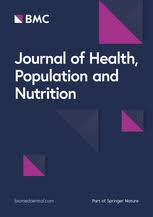Prevalence of goitre in Isfahan, Iran, fifteen years after initiation of universal salt iodization
Authors
Affiliations
Abstract
This cross-sectional study investigated the prevalence of goitre in Isfahan, a centrally-located city in Iran, 15 years after the initiation of universal salt iodization. In total, 2,523 Isfahani adults (1,275 males, 1,248 females) aged > 20 years were selected by multi-stage cluster-sampling method. Goitre rate, serum thyroid-stimulating hormone (TSH), thyroxine (T4), thyroid peroxidase antibody (TPOAb), thyroglobulin antibody (TgAb), and urinary iodine concentration (UIC) were measured and compared between the goitrous (n = 478) and the non-goitrous (n = 2,045) participants. The total goitre rate was 19% (n = 478) of the 2,523 adults. The rate of Grade I and II goitre was 12.4% (n = 312) and 6.6% (n = 166) respectively. The total goitre rate, Grade I and II goitre were more prevalent among women than among men. Hypothyroidism was observed in 6.4% (130/2,045) and 18.6% (89/478) of the non-goitrous and goitrous participants respectively [odds ratio (OR) = 3.6, 95% confidence interval (CI) 2.7-4.9, p = 0.001]. Hyperthyroidism was present in 0.8% (17/2,045) and 5.2% (29/478) of the non-goitrous and goitrous adults respectively (OR = 9.0, 95% CI 4.9-16.6, p = 0.001). Hypothyroidism was more prevalent in Grade II than in Grade I goitre and among those without goitre (31.3%, 14.1%, and 6.4% respectively) (p = 0.001). Positive TPOAb was observed in 24% (n = 50) of the non-goitrous and 33.5% (n = 84) of the goitrous subjects (p = 0.03). Positive TPOAb was observed in 24.6% (35 of 142) of the Grade I and 45% (49 of 109) of the Grade II goitrous adults (p = 0.001). Positive TgAb was observed in 21.6% (n = 45) of the non-goitrous and 35.9% (n = 90) of the goitrous adults (p = 0.001). Positive TgAb was observed in 30.3% (43 of 142) of the Grade I and 43.1% (47 of 109) of the Grade II goitrous adults (p = 0.04). The median UIC was 18 microg/dL (range 1-80 microg/dL). It was 17.9 microg/dL and 19 microg/dL in the non-goitrous and goitrous adults respectively. After 15 years of successful universal salt iodization in Isfahan, goitre is still endemic, which may be due to thyroid autoimmunity. However, other environmental or genetic factors may have a role.
Key words: Autoimmunity; Cross-sectional studies; Goitre; Hypothyroidism; Hyperthyroidism; Impact studies; Iodine; Iodine deficiency; Iran
How to Cite
Aminorroaya A, Amini M, Hovsepian S. Prevalence of goitre in Isfahan, Iran, fifteen years after initiation of universal salt iodization. J Health Popul Nutr. 2010 Aug;28(4):351-8. doi: 10.3329/jhpn.v28i4.6041. PMID: 20824978; PMCID: PMC2965326.

